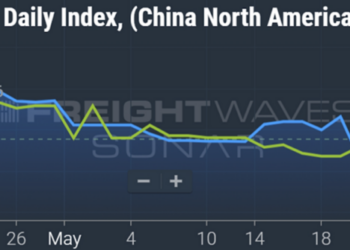Transportation metrics were less bad in October, according to a survey of supply chain executives.
The Logistics Managers’ Index (LMI) report showed transportation capacity continued to expand and pricing continued to decline but at less severe rates. The data is compiled in a diffusion index where a reading above 50 indicates expansion while one below 50 signals contraction.
Transportation capacity (56.7) continued to increase in October but at a rate that was 7.6 percentage points lower than in September. The October reading was the slowest growth rate registered since March 2022. The capacity reading was just 52.3 in the back half of October compared to 60.6 at the beginning of the month.
Capacity utilization (60.7) was up 7.2 points from September and well above a 41.8 reading in July.
Transportation prices (44.4) declined for a 16th straight month, but the October level was nearly 1 point higher than the prior month. Downstream companies closer to the consumer like retailers actually reported growth in transportation rates, registering a 53.7 reading.
“The freight recession is by no means over,” the report said. “But with all three of our transportation metrics hitting their most encouraging readings in over a year, we may be taking steps in the right direction (something our respondents seem to reaffirm in their future predictions).”
When asked to forecast conditions one year out, respondents returned an inverted outlook. Future transportation capacity had a reading of 47.8, which was 6.1 points lower than the prior-month reading.
Transportation utilization is expected to be 65.2 a year from now, with pricing at 65.0.
Chart: (SONAR: NTIL.USA). The National Truckload Index (linehaul only – NTIL) is based on an average of booked spot dry van loads from 250,000 lanes. The NTIL is a seven-day moving average of linehaul spot rates excluding fuel. Spot rates are currently 10% lower y/y.
The overall LMI was up 4.1 points to 56.5 during the month. October was the third straight month the growth rate increased but it remained below the all-time average of 62.8 for the 7-year-old index.
Inventory Levels (53.4) moved back into expansion territory following five months of contraction. Inventory levels grew 8.5 points faster for downstream respondents (59.3) than they did for upstream manufacturers and wholesalers.
“Whether increased inventories are temporary bursts of seasonal expansion or the sign of a larger move back towards stronger economic growth remains to be seen,” the report said. “What we can say however is that October’s inventory and overall index scores are a marked step forward for the logistics industry.”
The survey showed warehousing capacity (57) continued to expand but utilization (66.9) also continued to grow. Warehousing prices (70.7) were down slightly in the month but remained well into inflationary territory.
The LMI is a collaboration among Arizona State University, Colorado State University, Florida Atlantic, Rutgers University and the University of Nevada, Reno, conducted in conjunction with the Council of Supply Chain Management Professionals.
More FreightWaves articles by Todd Maiden
RXO expands through the downcycle
Schneider posts cost-burdened Q3
Werner’s Q3 light of expectations
The post Ramp in transportation capacity slows in October, report says appeared first on FreightWaves.














